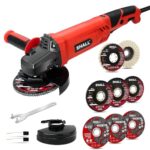An angle grinder is a handheld power tool that is used for grinding, sanding, and polishing. The armature is the part of the angle grinder that rotates. It is important to test the armature of your angle grinder regularly to ensure that it is in good working condition.
- To test the armature of an angle grinder, first, disconnect the power cord from the grinder
- Next, remove the spark plug and any other removable parts from the grinder
- With the parts removed, inspect the armature for cracks or damage
- If there is any damage to the armature, it will need to be replaced
- To test if the armature is functioning properly, connect it to a power source and watch for sparks coming from the brushes
- 6 If no sparks are coming from the brushes, then the armature is likely defective and will need to be replaced
You May Like
How to Test Angle Grinder Armature? Details Step
How Do You Test an Armature With a Multimeter?
If you’re troubleshooting an armature with a multimeter, there are a few things you can test to see if it’s functioning properly. First, you’ll want to check the resistance of the armature winding. This can be done by disconnecting one lead of the armature from the power source and connecting it to one lead of the multimeter.
Then, connect the other lead of the multimeter to the other lead of the armature. The resistance should be within specifications for the particular armature you’re testing. If it’s not, then the armature may be damaged and will need to be replaced.
Next, you can test for continuity across the commutator segments. To do this, disconnect both leads of the armature from the power source and touch one probe of the multimeter to each segment in turn. There should be continuity between every pair of segments.
If there’s an open circuit or a short circuit between any two segments, that indicates a problem with the commutator and will need to be repaired or replaced. Finally, you can test for the voltage drop across each commutator segment while the armature is powered up and running under load. This will tell you if there are any bad connections in the windings or if there’s excessive resistance causing voltage loss.
To do this test, connect one lead of your multimeter to each terminal on one side of all the segments in turn and measure the voltage drop across each segment while under load conditions; it should be less than 0 .5 volts for most applications. If any segment has a higher voltage drop than that, it indicates a problem that needs to be addressed.
How Do I Test an Armature Field?
An armature field is a device that generates a magnetic field to rotate an armature. The armature is the rotating part of an electric motor or generator. To test an armature field, you will need a gaussmeter.
First, you will need to make sure that the armature is properly secured. Next, you will need to find the north and south poles of the armature with your gaussmeter. Once you have found the poles, you will need to measure the strength of the magnetic field between them.
Finally, you will need to compare your results to the manufacturer’s specifications.
What Test Instrument is Used to Test an Armature?
An armature is a rotating part of an electrical machine, typically the winding in which current is induced by magnetic action. It is also known as field winding. The armature can be on either the rotor or the stator, depending on whether the machine is a rotary or linear type.
The most common test instrument used to test an armature is a digital multimeter (DMM). This device measures the electric potential difference and the current flowing through an electrical circuit. DMMs are available in both handheld and benchtop models.
Other instruments that can be used to test armatures include ohmmeters, ammeters, and wattmeters.
What Causes Armature Failure?
If you’re a motorhead, then you know that one of the most important parts of an electric motor is the armature. The armature is what produces the magnetic field that interacts with the field produced by the stator to create rotational force. Without a properly functioning armature, your engine will die in the water.
So what causes armature failure? There are a few different things that can cause armature failure. One of the most common is simply wearing and tearing.
Over time, the armature can become damaged from all the heat and friction it’s subjected to while in operation. This damage can eventually lead to cracks or breaks in the armature itself, which will cause it to fail. Another common cause of armature failure is electrical issues.
If there’s a problem with the way electricity is flowing through the armature, it can overheat and break down prematurely. This is often caused by loose connections or damaged wires somewhere in the system. Finally, poor manufacturing can also lead to armatures that are more likely to fail prematurely.
If an armature isn’t made correctly from the start, it may not be able to handle all the stress it will be placed under during use and could easily break down as a result. Luckily, this type of failure is relatively rare nowadays thanks to better quality control measures in place at factories that produce them.
Symptoms of a Bad Armature
An armature, or armature winding, is the primary winding in an electromagnetic system. It is wound on an iron core and creates a magnetic field that interacts with the field created by the permanent magnets to generate rotational force. If your armature is bad, you’ll likely experience a reduction in power and torque.
Additionally, your motor may run hotter thausualal and produce strange noises. If you suspect that your armature is bad, it’s important to have it checked out by a professional as soon as possible to avoid further damage to your motor.
How to Test an Armature With a Multimeter
An armature is the heart of an electromechanical device such as an electric motor, and it is essential to test it regularly to ensure that it is in good working order. There are a few different ways to test an armature, but using a multimeter is generally the most accurate method. To test an armature with a multimeter, first, disconnect it from any power source.
Then, set your multimeter to the resistance setting and touch the probes to the two terminals on the armature. If the armature is functioning properly, you should see a reading of around 0.5 ohms. If you don’t get a reading or you get a reading that’s significantly different from 0.5 ohms, then there may be something wrong with your armature and it will need to be replaced.
How to Test a Generator Armature
An armature is the central component of an electric generator, and testing it is essential to ensuring the proper function of the generator. There are a few different ways to test an armature, but the most common is known as a resistance test. This involves measuring the resistance of each winding in the armature using an ohmmeter.
The results of this test can tell you if there are any problems with the armature windings or if they are shorted out. Another way to test an armature is known as an insulation test. This involves measuring the insulation between the winding and frame of the armature.
The results of this test can tell you if there are any problems with the insulation on the armature.
Armature Winding Resistance
Armature winding resistance is one of the most important factors in designing an electric motor. It determines the amount of current that flows through the armature windings and affects the torque, speed, and power output of the engine. The resistance also determines how much heat is generated in the armature windings, which can impact the reliability and longevity of the motor.
Several factors affect armature winding resistance, including:
-The number of turns in the winding: More turns will result in more resistance.
-The cross-sectional area of the wire: A larger cross-sectional area will result in less resistance.
-The length of the wire: A longer length of wire will result in more resistance.
-The resistivity of the wire: A material with a higher resistivity (such as copper) will have more resistance than a material with a lower resistivity (such as aluminum).
How to Test Armature Windings
If you have an armature winding that needs to be checked for proper resistance, there are a few things that you need to do to test it. First, you need to make sure that the armature is not energized before beginning the testing process. If it is, then you could risk getting electrocuted.
Second, you’ll need to use an ohmmeter to measure the resistance of the armature winding. To do this, simply touch the leads of the ohmmeter to the two ends of the winding. If the reading is within the normal range for that particular type of armature winding, then it’s likely that the winding is in good condition.
However, if the reading is outside of the normal range, then there may be something wrong with the armature winding and further investigation will be necessary.
Commutator Bar To-Bar Test
The Commutator Bar To-Bar Test is a quick and easy way to test the health of your vehicle’s battery. This test can be performed with a multimeter and requires no disassembly of the battery. The test is performed by measuring the resistance between the positive and negative terminals of the battery.
If the resistance is low, this indicates that the battery is in good health. If the resistance is high, this indicates that there may be an issue with the battery.
Commutator Test Procedure
The commutator is an essential part of any DC motor. It ensures that the current flowing through the armature windings is always in the correct direction, regardless of the direction of rotation of the armature. A good commutator will provide smooth and reliable operation of a DC motor over its lifetime.
However, like any other mechanical component, the commutator can eventually wear out or become damaged, causing problems with the operation of the motor. It is therefore important to periodically test the commutator to ensure that it is in good condition. This blog post will explain how to carry out a simple test of the commutator.
The first step is to disconnect the power supply to the motor. Once this has been done, you need to remove the brushes from their holders so that they do not make contact with the Commutator segments when you rotate the armature by hand. With the power disconnected and the brushes removed, you can now rotate the armature by hand to check for any roughness or binding in its movement. If there is any roughness or binding, it indicatesthatthecommutatorsegmentsarewearingoutandneedtobereplaced.
If there is no roughness or binding to the movement of the armature, then you can proceedto test for continuity between each of the segments Singa a multimeter set to the “ohm” scale. To do this, you will need to touch one lead of your multimeter to one terminal of each segment in turnandcheckthat there is continuity between that segment and the next one in line
(I). If there is no continuity between two adjacent segments, then thisindicatesthatthe connectionbetweenthemhasbeen lost andthatthesegmentswill needtobere-connectedbeforethecommutatortest canbeconsideredcomplete.
(ii) Finally, once youhaveconfirmedthat all of the segmentshavecontinuitywithone another, you can replace the brushesintotheirholdersand reconnect the powersupplytothemotorbeforecarryingoutafull functiontestofthemotor itself.
Conclusion
Angle grinders are versatile tools that can be used for a variety of projects. However, before using an angle grinder, it’s important to test the armature. Here’s how:
1. First, make sure that the armature is clean and free of debris.
2. Next, connect the armature to a power source and turn on the power switch.
3. Then, slowly move the armature back and forth while observing the movement of the brushes.
The brushes should move smoothly without any interference.

Hi, this is Cynthia A. Rose. Welcome to my Grinder related blog. Usually, I am busy with my kitchen and cooking all day. My main desire is to create a new recipe every day. But I have to use new tools every day to create new recipes. In this blog, I will share you how to use kitchen tools properly. I will not just share cooking related equipment, I will try to review all kinds of grinders like angle grinder among you. I hope my 12 years of experience will come in handy. Thanks!







